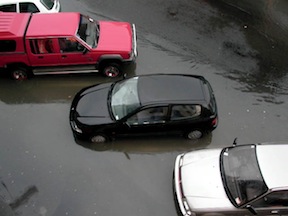
Among the property damaged by the flooding are vehicles, many of which are likely totaled.
Most flooded cars are demolished; however, a few end up on used car lots around the country. Cars that have been damaged by floods are very expensive and dangerous to drive, as corrosion from water damage spreads throughout a car over time, causing key parts to fail. These parts can be expensive to fix and can be deadly if they fail while you are driving.
If you are in the market for a new vehicle, we urge you to be on the lookout for flooded cars. These cars can appear pristine on the outside, but there are a few key signs that betray the hidden dangers. Take the following steps to protect yourself and your family:
Ask the dealer about flood damage. A reputable car dealership will tell you, in writing, that the car does not contain flood damage. If the dealer hesitates or refuses to give you a firm “no” in writing, this is a sign that the car is damaged. Also, ask the dealer to let you look at the title. Check for a stamp that says “Flood” or “Salvage.” You can also see if the car comes from a region, like Colorado, recently hit by flooding.
Check the car’s smell. Even the most thoroughly cleaned flooded cars often have a mold or mildew smell. If you get in the car and smell mold, this is a sure sign that the car has been exposed to a significant amount of water. If you aren’t sure, take the time to sit in the car with the windows and doors closed. If you smell a strong air freshener, this may indicate that the seller is trying to cover up an unpleasant smell—like mold or smoke.
Check for water. Water can collect just about anywhere. Check the carpet in the car and in the trunk for moisture or rust. Check the material underneath the spare tire, as this spot is often missed when the car is prepared for the lot.
Look for corrosion and rust. The most obvious sign of water damage is rust. Check for signs of rust and corrosion on screws, door hinges, hood springs, and trunk latches. Use a mirror to check under the seats and the outside of the car.
Test drive the car. Electrical damage in a car can be deadly. Test drive the car and make sure that all of the electrical components are working. Turn on the radio, dashboard lights, back lighting, headlights, turn signals, and emergency blinkers.
Ask a mechanic. Ask a mechanic to examine the car before signing on the dotted line. An experienced mechanic will be able to find the telltale signs of water damage.
By taking the steps above, you can help ensure that you buy a safe, reliable vehicle.
Our thoughts are with those whose lives have been affected by the catastrophic flooding in Colorado. If you would like to help, we encourage you to make a donation to the Red Cross or another organization providing aid to the area.